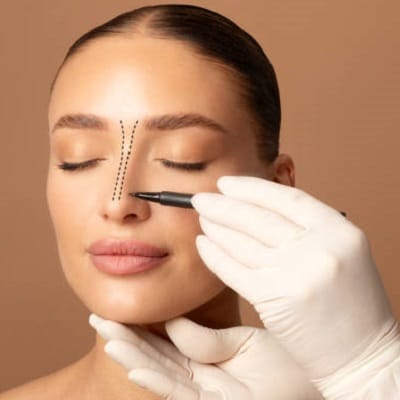
All Rhinoplasty procedures are created depending upon your needs as a patient. After the initial decision to go through a Rhinoplasty, the next step involves the help of your health care provider to evaluate which type of Rhinoplasty procedure you will require.
There are four types of Rhinoplasty procedures in practice. These are:
Closed Rhinoplasty
A closed Rhinoplasty is the most common type of Rhinoplasty. In this type of Rhinoplasty in Islamabad, all incisions are concealed inside the nose with no external marks. The surgeon lifts the soft tissue marginally upward, then the bone and cartilage are easily reached to carry out the necessary changes.
Due to its less-invasive nature there are quite a few advantages of closed Rhinoplasty, these advantages are:
- Reduced nasal tissue irritation due to the lack of incisions
- Reduced chances of the nasal-tip support reduction
- Smaller probability of post-operative swelling
- Lessened visible scarring
- Require minimum time to execute
- Faster postoperative recovery
Open Rhinoplasty
An open Rhinoplasty has generally been suitable for patients who require extensive work done to the nose. In this type of Rhinoplasty, your surgeon will make necessary incisions in the skin between your nostrils under your nose. Next, the surgeon lifts the in order to expose the inside of the nasal cavity, giving your Rhinoplasty surgeon easy access to perform the required reshaping.
Some surgeons opt for open Rhinoplasty as their main technique of surgery depending on the training and skill of the physician. Open Rhinoplasty procedures are best suitable for patients who are having the following issues:
- Distorted valves from earlier hump removal
- Inherited, structural irregularities in the nose
- Developed irregularities in the nose
- Discontent with the appearance of the nose after previous nasal surgery
After an open Rhinoplasty, the skin is stitched and the nose is taped for stabilization purposes. After the taping, a nasal split that has been carved especially for the nose is placed over the tape. The splint is helpful to protect the delicate tissues of your new nose during the healing process. It will be detached almost one week after the surgery.
Filler Rhinoplasty
A filler Rhinoplasty also is known as non-surgical Rhinoplasty is a less common type of nose surgery in Islamabad. In this type of Rhinoplasty, no incisions are made, the injectable filler is used to correct minor flaws in the nose.
Facts about Filler Rhinoplasty
- Safety:
Surgeons usually consider this type of Rhinoplasty as efficient and safe.
- Convenience:
Non-Surgical Rhinoplasty is an outpatient procedure, which makes it far more convenient than surgical alternatives.
A trained health care provider can complete the procedure in 15 minutes or less.
Normally you can be back at work on the same day.
- Cost:
Non-Surgical Rhinoplasty is less expensive than a traditional Rhinoplasty.
Revision Rhinoplasty
Revision Rhinoplasty is a succeeding surgery after a primary Rhinoplasty. Usually, patients opt for a revision Rhinoplasty if they are not happy with the results of the primary Rhinoplasty or if they look for further changes that were not originally desired in the primary Rhinoplasty.
A revision Rhinoplasty is an ideal option for those patients who desire a “touch-up.” Most revision Rhinoplasty surgeries involve the simple abstraction of remaining cartilage or bone from the bridge of the nose. However, sometimes it is performed on individuals who have had too much cartilage or bone removed in previous surgery and resulting in a severe abnormality.



